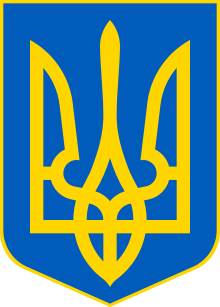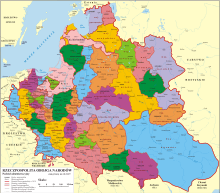Lesser Poland Province of the Polish Crown

Lesser Poland Province was an administrative division of the Crown of the Kingdom of Poland from 1569 until 1793. It comprised the administrative subdivisions of Kraków, Sandomierz, and Lublin, plus the Duchy of Siewierz. The name of the province comes from historic land of Lesser Poland. Polish historian Henryk Wisner in his 2002 book Rzeczpospolita Wazów. Czasy Zygmunta III i Władysława IV writes that it is not known when lands of the Polish Crown were divided into the two provinces:
"Parallel to the Crown of the Kingdom of Poland, and the Grand Duchy of Lithuania, provinces existed, which should be called Sejm provinces, as they became visible during its sessions; mostly during election of the Marshal of the Sejm, and the royal election. These were Provinces of Lithuania, Greater Poland, and Lesser Poland. First one covered the Grand Duchy of Lithuania, the remaining two were artificially made, and it is not known who and in what way created them. We know that the Sejm was not involved in creation of these provinces".[1]
Zygmunt Gloger in his book Historical Geography of the Lands of Old Poland (1900) provides this description of the Province of Lesser Poland:
“Lesser Poland proper was made of three voivodeships: those of Krakow, Sandomierz, and Lublin, plus the Duchy of Siewierz, purchased in the 15th century by Bishop of Krakow Zbigniew Olesnicki. Furthermore, to Lesser Poland belonged thirteen towns of Spiš, located behind the Carpathians. Altogether, Lesser Poland had the area of 1,046 sq. miles, which was 6 sq. miles less than Greater Poland. In the mid-16th century, the three voivodeships of Lesser Poland (without Siewierz and Spis) had 922 Roman-Catholic parishes, 205 towns and 5,500 villages.
Following the 1569 Union of Lublin, the lands of Red Ruthenia, Volhynia, Podolia and Ukraine were annexed by the Kingdom of Poland, joining the Province of Lesser Poland. As a result, Lesser Poland consisted of eleven voivodeships, three duchies (Duchy of Oswiecim, Duchy of Zator, and Duchy of Siewierz), and three lands: those of Chelm, Halicz, and Lukow".[2]
Lesser Poland Province
- Bełz Voivodeship (województwo bełzkie, Bełz)
- Bracław Voivodeship (województwo bracławskie, Bracław)
- Czernichów Voivodeship (województwo czernichowskie, Czernichów)
- Kijów Voivodeship (województwo kijowskie, Kijów)
- Kraków Voivodeship (województwo krakowskie, Kraków), together with the Duchy of Oświęcim, Duchy of Zator, and thirteen towns of Spiš,
- Lublin Voivodeship (województwo lubelskie, Lublin), together with the Łuków Land,
- Podlaskie Voivodeship (województwo podlaskie, Drohiczyn). According to Henryk Wisner, this voivodeship was for a short time part of the Province of Greater Poland, and it is not known when it became to be associated with Lesser Poland,
- Podole Voivodeship (województwo podolskie, Kamieniec Podolski)
- Ruś Voivodeship (województwo ruskie, Lwów), together with Chełm Land and Halicz Land,
- Sandomierz Voivodeship (województwo sandomierskie, Sandomierz)
- Wołyń Voivodeship (województwo wołyńskie, Łuck)
- Duchy of Siewierz (Siewierz)
Sources
- ↑ Henryk Wisner, Rzeczpospolita Wazów. Czasy Zygmunta III i Władysława IV. Wydawnictwo Neriton, Instytut Historii PAN, Warszawa 2002, page 26
- ↑ Zygmunt Gloger (1900). Geografia historyczna ziem dawnej Polski (in Polish). Kraków: Spółka Wydawnicza Polska. ISBN 83-214-0883-4.


